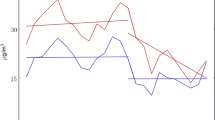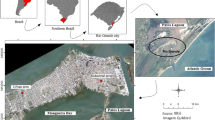Abstract
This study investigates the water-soluble ionic constituents (Na+, K+, NH4 +, Ca2+, Mg2+, Cl−, NO3 −, SO4 2−) associated to PM2.5 particle fraction at two urban sites in the city of Thessaloniki, northern Greece, an urban traffic site (UT) and urban background site (UB). Ionic constituents represent a significant fraction of PM2.5 mass (29.6 at UT and 41.5 % at UB). The contribution of marine aerosol was low (<1.5 %). Secondary inorganic aerosols (SIA) represent a significant fraction of PM2.5 mass contributing to 26.9 ± 12.4 % and 39.2 ± 13.2 % at UT and UB sites, respectively. Nitrate and sulfate are fully neutralized by ammonium under the existing conditions. The ionic constituents were evaluated in relation to their spatial and temporal variation, their gaseous precursors, meteorological conditions, local and long-range transport.







Similar content being viewed by others
References
Argyropoulos G, Samara C, Nikolaou K (2011) Source apportionment of PM10 in Thessaloniki. In: the 4th Environ Conf of Macedonia, Greece, Thessaloniki, 18–20 Mar 2011 (in Greek)
Baek BH, Anaja VP, Tong Q (2004) Chemical coupling between ammonia, acid gases, and fine particles. Environ Pollut 129:89–98
Bencs L, Ravindra K, de Hoog J, Rasoazanany EO, Deutsch F, Bleux N, Berghmans P, Roekens E, Krata A, Van Grieken R (2008) Mass and ionic composition of atmospheric fine particles over Belgium and their relation with gaseous air pollutants. J Environ Monit 10:1148–1157
Bressi M, Sciare J, Ghersi V, Bonnaire N, Nicolas JB, Petit JE, Moukhtar S, Rosso A (2013) A one-year comprehensive chemical characterisation of fine aerosol (PM2.5) at urban, suburban and rural background sites in the region of Paris (France). Atmos Chem Phys 13:7825–7844
Daher N, Ruprecht A, Invernizzi G, De Marco C, Miller-Schulze J, Heo JB, Shafer MM, Shelton BR, Schauer JJ, Sioutas C (2012) Characterization, sources and redox activity of fine and coarse particulate matter in Milan. Italy Atmos Environ 49:130–141
Draxler RR, Rolph GD (2013) HYSPLIT (HYbrid Single-Particle Lagrangian Integrated Trajectory) Model access via NOAA ARL READY. http://ready.arl.noaa.gov/ HYSPLIT.php. NOAA Air Resources Laboratory, Silver Spring, MD.
EC (2008) Directive 2008/50/EC of the European Parliament and of the Council on ambient air quality and cleaner air for Europe. 21 May 2008.L 152/1 11.6.2008
EEA (2012) EEA Technical report No 6/2012, Denmark
Flocas H, Kelessis A, Helmis C, Petrakakis M, Zoumakis M, Pappas K (2009) Synoptic and local scale atmospheric circulation associated with air pollution episodes in an urban Mediterranean area. Theor Appl Climatol 95:265–277
Galindo N, Yubero E, Nicolas JF, Crespo J, Pastor C, Carratalá A, Santacatalina M (2011) Water-soluble ions measured in fine particulate matter next to cement works. Atmos Environ 45:2043–2049
Helmis CG, Tombrou M, Asimakopoulos DN, Soilemes A, Gusten H, Moussiopoulos N, Hatzaridou A (1997) Thessaloniki 91 field measurement campaign. I. Wind field and atmospheric boundary layer structure over greater Thessaloniki area under light background flow. Atmos Environ 31:1101–1114
Horemans B, Krata A, Buczynska AJ, Dirtu AC, Van Meel K, Van Grieken R, Bencs L (2009) Major ionic species in size-segregated aerosols and associated gaseous pollutants at a coastal site on the Belgian North Sea. J Environ Monit 11:670–677
IPPC-Intergovernmental Panel on Climate Change (2007) IPCC fourth assessment report 2007. Cambridge University Press, London
Kassomenos PE, Kelessis E, Paschalidou AK, Patrakakis M (2011) Identification of sources and processes affecting particulate pollution in Thessaloniki. Greee Atmos Environ 45:7293–7300
Karageorgos ET, Rapsomanikis S (2007) Chemical characterization of the inorganic fraction of aerosols and mechanisms of the neutralization of atmospheric acidity in Athens. Greece Atmos Chem Phys 7:3015–3033
Lin CC, Huang KL, Chen SJ, Liu SC, Tsai JH, Lin YC, Lin WY (2009) NH4 +, NO3 −, and SO4 2− in roadside and rural size-resolved particles and transformation of NO2/SO2 to nanoparticle-bound NO3 −/SO4 2−. Atmos Environ 43:2731–2736
Liu X, Zhu J, Van Espen P, Adams F, Xiao R, Dong S, Li Y (2005) Single particle characterization of spring and summer aerosols in Beijing: formation of composite sulphate of calcium and potassium. Atmos Environ 39:6909–6918
Middlebrook AM, Bahreini R, Jimenez JL, Canagaratna MR (2012) Evaluation of composition-dependent collection efficiencies for the aerodyne aerosol mass spectrometer using filed data. Aerosol Sci Tech 46:258–271
Ostro B, Feng WY, Broadwin R, Green S, Lipsett M (2007) The effects of components of fine particulate air pollution on mortality in California: results from CALFINE. Environ Health Perspect 115:13–19
Pacyna JM (1998) Source inventories for atmospheric trace metals. In: Harrison RM, van Grieken RE (eds) Atmospheric particles, vol 5, IUPAC series on analytical and physical chemistry of environmental systems. Wiley, Oxford, pp 387–423
Pathak RK, Wu WS, Wang T (2009) Summertime PM2.5 ionic species in four major cities of China: nitrate formation in an ammonia-deficient atmosphere. Atmos Chem Phys 9:1711–1722
Pey J, Querol X, Alastuey A (2009) Variations of levels and composition of PM10 and PM2.5 at an insular site in the Western Mediterranean. Atmos Res 94:285–299
Pope CA 3rd, Dockery DW (2006) Health effects of fine particulate air pollution: lines that connect. J Air Waste Manag Assoc 56:709–742
Putaud JP, van Dingenen R, Alastuey A, Bauer H, Birmili W, Cyrys J, Flentje H et al (2010) A European aerosol phenomenology-3: physical and chemical characteristics of particulate matter from 60 rural, urban, and kerbiside sites across Europe. Atmos Environ 44:1308–1320
Querol X, Alastuey A, Moreno T, Viana MM, Castillo S, Pey J, Rodríguez S et al (2008) Spatial and temporal variations in airborne particulate matter (PM10 and PM2.5) across Spain 1999–2005. Atmos Environ 42:3964–3979
Ro CU, Oh KY, Kim H, Kim YP, Lee CB, Kim KH, Kang CH, Osaan J, de Hoog J, Worobiec A, Van Grieken R (2001) Single-particle analysis of aerosols at Cheju Island, Korea, using low-Z electron probe X-ray microanalysis: a direct proof of nitrate formation from sea salts. Environ Sci Technol 35:4487–4494
Rolph GD (2013) Real-time Environmental Applications and Display sYstem (READY). http://ready.arl.noaa.gov. NOAA Air Resources Laboratory, Silver Spring, MD
Saffari A, Daher N, Samara C, Voutsa D, Kouras A, Manoli E, Karagkiozidou O, Vlachokostas C, Moussiopoulos N, Shafer MM, Schauer JJ, Sioutas C (2013) Increased biomass burning due to the economic crisis in Greece and its adverse impact on winter-time air quality in Thessaloniki. Environ Sci Technol 47:13313–13320
Salvador P, Artiňano B, Vian M, Alastuey A, Queril X (2012) Evaluation of the changes in the Madrid metropolitan area influencing air quality: analysis of 1999–2008 temporal trend of particulate matter. Atmos Environ 57:175–185
Samara C, Voutsa D, Kouras A, Eleftheriadis K, Maggos T, Saraga D, Petrakakis M (2013) Organic and elemental carbon associated to PM10 and PM2.5 at urban sites of northern Greece. Environ. Sci. Pollut. Res. (doi 10.1007/s11356-013-2052-8)
Samara C, Kouimtzis T, Tsitouridou R, Kanias G, Simeonov V (2003) Chemical mass balance source apportionment of PM10 in an industrialized urban area of Northern Greece. Atmos Environ 37:41–54
Samara C, Tsitouridou R (2000) Fine and coarse ionic aerosol components in relation to wet and dry deposition. Wat Air &Soil Pollut 120:71–88
Schaap M, van Loon M, ten Brink HM, Dentener FJ, Builtjes PJH (2004) Secondary inorganic aerosol simulations for Europe with special attention to nitrate. Atmos Chem Phys 4:857–874
Seinfeld JH, Pandis SN (1998) Atmospheric Chemistry and Physics: from Air Pollution to Climate Change. Wiley, New York
Seinfeld JH, Pandis SN (2006) Atmospheric Chemistry and Physics from Air Pollution to Climate Change. Wiley, New York
Shon ZH, Kim KH, Song SK, Jung K, Kim NJ, Lee JB (2012) Relationship between water-soluble ions in PM2.5 and their precursor gases in Seoul megacity. Atmos Environ 59:540–550
Szigeti T, Mihucz VG, Ovari M, Baysal A, Atilgam S, Akman S, Zaray G (2012) Chemical characterization of PM2.5 fractions of urban aerosol collected in Budapest and Istanbul. Microchem J 107:86–94.
Squizzato S, Masiol M, Innocente E, Pecorari E, Rampazzo G, Pavoni B (2012a) A procedure to assess local and long-range transport contributions to PM2.5 and secondary inorganic aerosol. J. of Aerosol Science 46: 64–76
Squizzato S, Masiol M, Brunelli A, Pistollato S, Tarabotti E, Rampazzo G, Pavoni B (2012b) Factors determining the formation of secondary inorganic aerosol: a case study in the Po Valley (Italy). Atmos Chem Phys Discuss 12:16377–16406
Stockwell WR, Kuhns H, Etyemezian V, Green MC, Chow JC, Watson JG (2003) The Treasure Valley secondary aerosol study II: modeling of the formation of inorganic secondary aerosols and precursors for Southwestern Idaho. Atmos Environ 37:525–534
Terzi E, Argyropoulos G, Bougiatioti A, Mihalopoulos N, Nikolaou K, Samara C (2010) Chemical composition and mass closure of ambient PM10 at urban sites Atmos. Environ 44:2231–2239
Terzi E, Gemenetzis P, Petrakakis M, Samara C (2007) Size distribution of ionic components in the urban area. In: Proceedings of the 10th international conference on environmental science and technology, Kos island, Greece. p. A1415-1422
Theodosi C, Grivas G, Zarmpas P, Chaloulakou A, Mihalopoulos N (2011) Mass and chemical composition of size-segregated aerosols (PM1, PM2.5, PM10) over Athens, Greece: local versus regional sources. Atmos Chem Phys 11:11895–11911
Tsitouridou R, Voutsa D, Kouimtzis T (2003) Ionic composition of PM10 in the area of Thessaloniki, Greece. Chemosphere 52:883–891
Voutsa D, Samara C, Kouimtzis T, Ochsenkuehn K (2002) Elemental composition of airborne particulate matter in a multi-impacted urban area of Thessaloniki. Greece Atmospheric Environment 36:4453–4462
Viana M, Maenhaut W, Chi X, Querol X, Alastuey A (2007) Comparative chemical mass closure of fine and coarse aerosols at two sites in south and west Europe: implications for EU air pollution policies. Atmos Environ 41:315–326
Wang Y, Zhuang G, Tang A, Yuan H, Sun Y, Chen S, Zheng A (2005) The ion chemistry and the source of PM2.5 aerosol in Beijing. Atmos Environ 39:3771–3784
Yao X, Zhang L (2012) Chemical processes in sea-salt chloride depletion observed at a Canadian rural coastal site. Atmos Environ 46:189–194
Zhao Y, Gao Y (2008) Acidic species and chloride depletion in coarse aerosol particles in the US east coast. Sci Total Environ 407:541–547
Zhang Y, Obrist D, Zielinska B, Gertler A (2013) Particulate emissions from different types of biomass burning. Atmos Environ 72:27–35
Acknowledgements
This work was supported by the European Community (LIFE + Environment Policy and Governance). The authors gratefully acknowledge Dr. Th. Grigoratos for his assistance in ion chromatographic analyses.
Author information
Authors and Affiliations
Corresponding author
Additional information
Responsible editor: Gerhard Lammel
Rights and permissions
About this article
Cite this article
Voutsa, D., Samara, C., Manoli, E. et al. Ionic composition of PM2.5 at urban sites of northern Greece: secondary inorganic aerosol formation. Environ Sci Pollut Res 21, 4995–5006 (2014). https://doi.org/10.1007/s11356-013-2445-8
Received:
Accepted:
Published:
Issue Date:
DOI: https://doi.org/10.1007/s11356-013-2445-8




